338 Euston Road for British Land
British Land’s fitout at Regent’s Place cut embodied carbon by 70%, let six months faster than the conventional industry approach and added value for customers. Paul Jaffe of British Land, Alan Dempsey of Nex Architects and Greg Lavery of Rype Office explain why it’s time for the industry to rethink what best practice looks like on commercial fitouts.
338 Euston Road is a 115,000 sq ft office building on British Land’s 13 acre Regent’s Place campus in Camden.
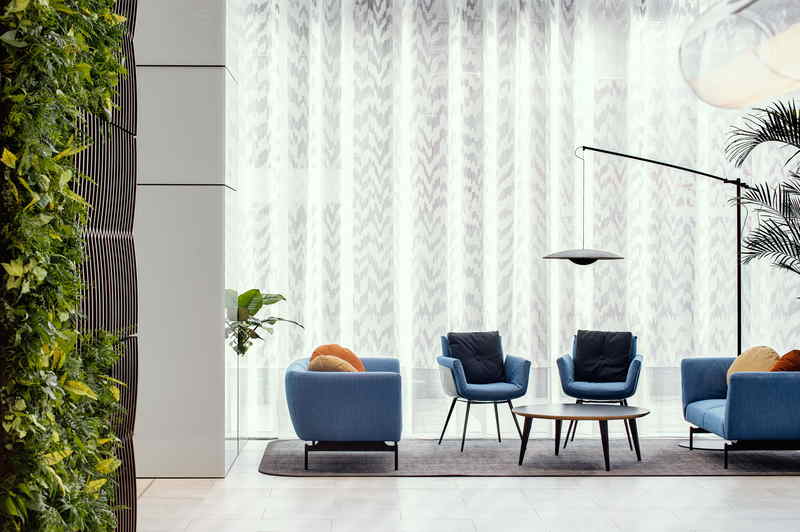
Circular fitout shows commercial value of sustainability leadership
Changing a mindset
Paul: Circular economy is the reuse – and designing for reuse – of materials and products. This is especially important in the building industry, where things are ripped out and replaced on a frequent cycle. We need to change this mindset.
Most people know that a lot of energy is used operating buildings. More people are recognising that construction also uses a huge amount of embodied energy. But fewer realise that fitouts are responsible for about a third of emissions over the life of a building.[i] Why so high? A typical building lasts around 60 years, but offices are refitted every eight years on average; and all the embodied energy that goes into producing, transporting and installing the new furniture, carpets, lighting and kitchens effectively goes in the bin.
Six months faster to let
Alan: At 338 Euston Road, British Land inherited a high quality customer fitout. The conventional approach would have been to strip this out and create an almost bare Cat A space, with raised floors, ceilings, lighting and a nominal amount of air handling. The next customer would then refit it to Cat B condition, installing new furniture, kitchens, flooring and partitioning.
Instead, British Land challenged us to remanufacture existing furniture and equipment in a way that not only dramatically cut the carbon impact and waste leaving site, but also improved occupier wellbeing – all for no additional cost!
The environmental benefits were astounding. We achieved a fully fitted out space, reusing about 70% of the embodied carbon versus a typical Cat B fitout. The financial benefits were also striking. Through a circular approach, we provided fully fitted Cat B space, including furniture, for the same cost as stripped back Cat A. British Land could then pass on this benefit to customers.
The market liked the circular model. The seven floors, where we repurposed existing materials and furniture to equip the space to Cat B condition, let six months faster than the top two floors (premium space), where we used the conventional Cat A model.
Cost and time benefits
Paul: There’s value for the customer because they save on fitout costs, which are usually around one to two years’ rent. Plus, they avoid the hassle of putting together a project team and making a myriad of design decisions, when all they really want to do is focus on their core business. Instead, they can walk in on day one and everything is already set up.
In turn, there’s value for the landlord because of the market appeal. We let the vast majority of 338 Euston Road before completing the refurbishment, showing the commercial value of sustainable practices. We also made another step in our journey to net zero carbon by 2030, cutting embodied carbon by 80kgCO2e per m2. This is equivalent to 2.5 years of the energy used running the building.
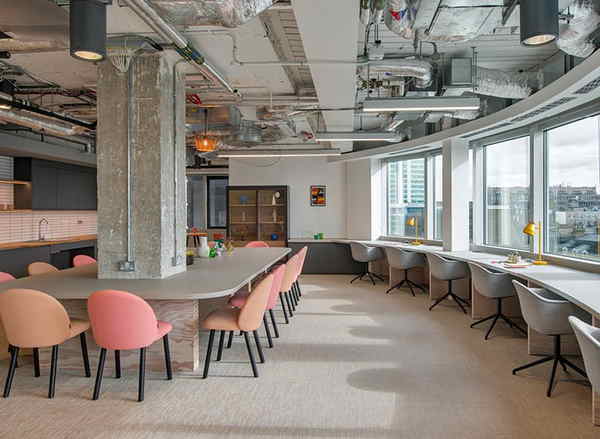
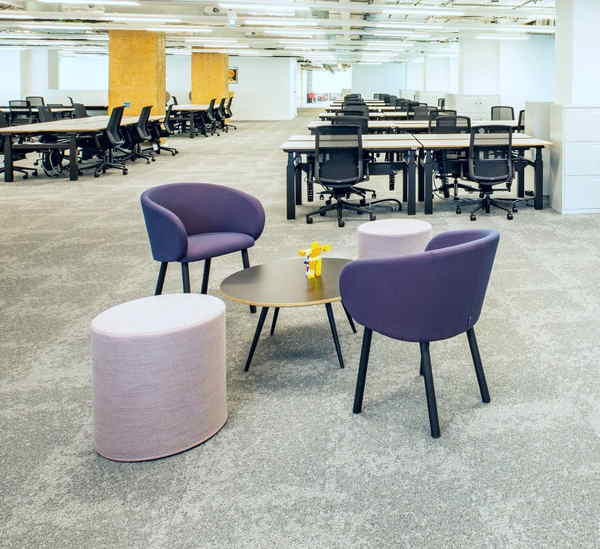
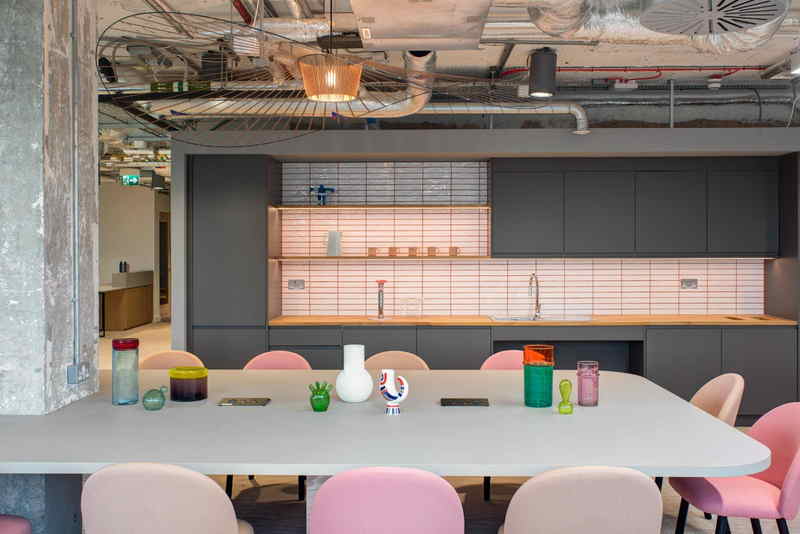
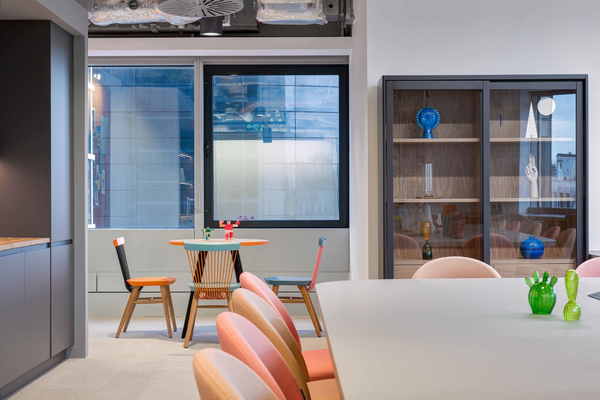
Closing the loop on furniture
Greg: We remanufactured nearly 250 items of furniture. First, we took an inventory of the furniture left by the previous occupier and British Land found a space on site for storage and a temporary workshop. This cut costs and transport emissions. An easy quick win. Then, we carried out quality checks and cleaned, fixed, reupholstered and resurfaced each item to perform and look as new.
Next, we worked with Nex Architects who mapped out what could be redeployed at 338 Euston Road. British Land also selected leftover items for Triton Café, where they were creating a new, sustainable community space. Finally, because Regent’s Place does a lot of outreach, the remaining items were offered to local groups.
So our zero waste approach delivered commercial, environmental and community benefits.
Growing wellbeing
Alan: Wellbeing was a big theme throughout. One of the biggest changes we made was moving the social, informal spaces to the best areas of the building: the south side, with sunlight and great views across London. Previously, those high value locations had been used for meeting rooms but, for wellbeing and productivity, it’s much better to use them for breakout areas where employees spend time.
We also transformed the vast reception area into an intimate and welcoming place. We introduced a 10m high wall made of bamboo and fabric to soften the acoustic dynamics. This is one of the first things people notice in how comfortable the space feels but can’t quite put their finger on. The wall has a lattice of plants growing upwards, selected based on a NASA study about species that enhance indoor air quality and lower volatile organic compounds (VOCs).[2]
Reusing furniture in itself brings wellbeing benefits. Materials give off most of the VOCs from production in the first year or two – that new carpet smell. We avoided this by refurbishing and reusing over 75% of the furniture in the breakout areas, meeting rooms and workspaces. And, wherever we introduced new products, we looked carefully at their sustainably credentials and VOCs.
A world of low carbon alternatives
Greg: In 50 years’ time, people are going to look back and ask: “What do you mean, you landfilled quality materials and furniture and bought new every eight years? What about the financial costs, greenhouse gas emissions and social value?”
Instead of today’s fast furniture model, imagine, as a building is about to be refurbished, that a team documents all the furnishings, fixtures and fittings. Designers then work with that inventory to refit the space. A completely closed loop, where materials go round in a virtuous circle. This would bring enormous savings in both money and emissions.
Perception is a key issue which, fortunately, is starting to change. High carbon furniture made from virgin resources is beginning to be seen as less attractive than low carbon circular economy furniture with provenance, such as desks that were in a James Bond movie (we remanufactured these a couple of years ago).
But there is a long way to go before low carbon circular fitouts are standard. That’s why British Land taking leadership on sustainability is so important. As the second largest REIT in the UK, people watch what they do.
Rethinking the model
Alan: There’s a fundamental problem with the prevailing model of landlords offering space in Cat A condition and then occupiers progressing it to Cat B. Why don’t we put responsibility for developing and fitting out space with the experts?
The circular model at 338 Euston Road played to British Land’s strengths; they have expertise in developing space commercially, sustainably, to a high quality and flexible for the future. It also gives occupiers fully fitted space to adapt and brand as their own. It’s an interesting niche between stripped back Cat A space and serviced offices or co-working space.
Rethinking the fitout model could have the single biggest impact in reducing the carbon footprint of buildings. It’s extraordinary that equipment gets discarded every eight years, when it could last far longer. Landlords have incentives to think long term because they own the building. So, they’re more likely to go for quality, durability and adaptability. Rather than thinking about a single lease, they could fit out with multiple occupiers in mind over a longer period. In turn, this would give occupiers greater flexibility for growth in a changing environment.
There are also opportunities for operational carbon savings. At 338 Euston Road, we validated and reused most of the plant and British Land is now responsible for running it, using their expertise to optimise operational efficiency. It was striking how British Land saw this project as another marker in their journey to net zero.
Moving fast
Paul: 338 Euston Road shows there’s market demand for the circular model. It just requires a change of mindset and a little more design time. Of course, the traditional Cat A model will always work for some customers. But, increasingly, and especially in a post-Covid world where flexibility of space and high quality partnerships with landlords are important, the circular model makes sound sense.
The property industry can move quickly when it has confidence in a process. So, the more commercially successful circular models there are, the better. The whole industry won’t change overnight, but I’m really looking forward to seeing where we can take this approach on different projects, working with forward thinking partners.
References:
[i] Treloar et al: Embodied energy analysis of fixtures, fittings and furniture in office buildings (1999).
[2] NASA 1989 study: https://ntrs.nasa.gov/api/citations/19930073077/downloads/19930073077.pdf
